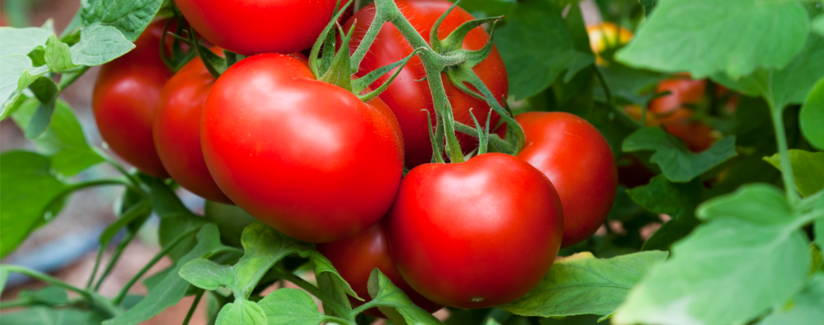
Health and How-Tos of Homegrown Tomatoes
08/01/2017
We’re here to get the juicy details of one the world’s favorite foods – tomatoes. They’re a vital part of almost every one of our favorite foods (we’re looking at you, pizza, French fries, spaghetti and salad!) and are popular with gardeners. Wanting to know more about this superfood, we had experts Dr. Herb Aldwinckle and Dr. Alice Henneman, MS, RD, answer some questions that we had about growing tomatoes and their nutritional value.
What are some of the health benefits of eating tomatoes?
Alice Henneman, MS, RD: “Tomatoes are one of the richest sources of dietary lycopene. Lycopene may help prevent such cancers as prostate, colorectal and stomach cancer as well as help lower your risk of cardiovascular disease. Cooked and canned tomatoes are higher in lycopene than raw tomatoes. Heating tomatoes during cooking, processing or canning increases the absorption of lycopene.
“Tomatoes are a source of potassium, Vitamin A and Vitamin C. Served plain, they are saturated fat- and cholesterol-free, very low in sodium and low in calories.”
What are the different ways to eat tomatoes?
Henneman: “Americans consume three-fourths of their tomatoes in processed form according to USDA’s Economic Research Service (ERS).”
The ERS estimates that the largest processed use of tomatoes goes as follows:
- Sauces (35 percent)
- Paste (18 percent)
- Canned whole tomato products (17 percent)
- Ketchup (15 percent)
- Juice (15 percent)
- ERS estimates suggest that about one-third of processed-tomato products are purchased away from home at various foodservice outlets (pizza parlors, for example).
Do homegrown tomatoes have different nutritional value than store bought?
Henneman: “The best answer I have seen to this question is a quote by dietitian Elizabeth Pivonka, former president and CEO of the nonprofit Produce for Better Health Foundation: ‘Still, home-grown produce may have only a slight nutritional advantage over the store-bought kind. What really matters,’ says Pivonka, ‘is that you eat more.’”
Many people think homegrown tomatoes taste better. Why is that?
Henneman: “Homegrown tomatoes are more likely to be picked and eaten at the peak of ripeness.”
If you want to try growing some yourself, here are some words of encouragement. “Start small. Grow what you like. Ask friends and neighbors for hints,” said Dr. Aldwinckle.
What are the best kind of tomatoes to grow yourself?
Dr. Aldwinckle: “There are many, many varieties, but they can be grouped into a few kinds.
Determinate (bush type, after a while plants stop growing more shoots and ripen the tomatoes they’re bearing) and indeterminate (keep growing and producing fruit until frost or diseases take them out). The size of fruit is grape, cherry, small, medium, large. There are also modern and heirloom varieties. I’ve been disappointed with heirlooms, their flavor and texture is no better, usually worse, than modern varieties. [Heirloom] rot quickly, and tend to be less resistant to diseases.”
Why do some tomatoes grow better than others?
Dr. Aldwinckle: “[There are] regular or disease resistant. Most modern varieties have some resistance, but if you run into serious disease problems, try some of those varieties specifically labeled ‘disease-resistant.’ These types of tomatoes can be easy or hard to get good fruit from, depending largely on the climate, the weather, the genetics of the variety, and the gardener’s skill, probably in that order.”
Do you have any tips or tricks for growing healthy tomatoes?
Dr. Aldwinckle: “Choose healthy well growing plants. Not too big, about 6 inches high. If possible, select a site where tomatoes have not been grown for 2-3 years.Tthis reduces carry-over of disease. Plant them in a loamy soil with plenty of (dark) organic matter. Space the plants so there will be space between them when mature, so that there can be airflow. Set the plants in the soil so the bottom part of the stem is buried (new roots will sprout and help support the plant. Water well, and fertilize them with one of those blue soluble fertilizers. Don’t let them dry out and wilt, keep watering regularly if it’s dry.
“Once the plants are 9 to 12 inches high, use twist-ties to attach them to a strong cane, or stake, or a length of metal conduit (easy to bash in the ground). Tie them loose enough to allow for growth. The staking will hold the fruit off the soil, where they can pick up disease, stay wet, and rot. It also makes picking a lot easier.”
Now that we know how to grow them, how do we keep our tomato plants healthy?
Dr. Aldwinckle: “Staking to keep fruit off the ground, and spacing to allow airflow to dry out the leaves and fruit after rain and dew will also help reduce diseases. I never spray. By the time you think you’ve got a big problem and wonder what to spray, it’s usually too late for any spray to have any useful effect. And who wants chemicals on their tomatoes anyway?”
We’re ready to see your picture-worthy tomato plants turn into even better recipes. To help you find inspiration for your tomato-based meals, we created a Pinterest board for you.



























